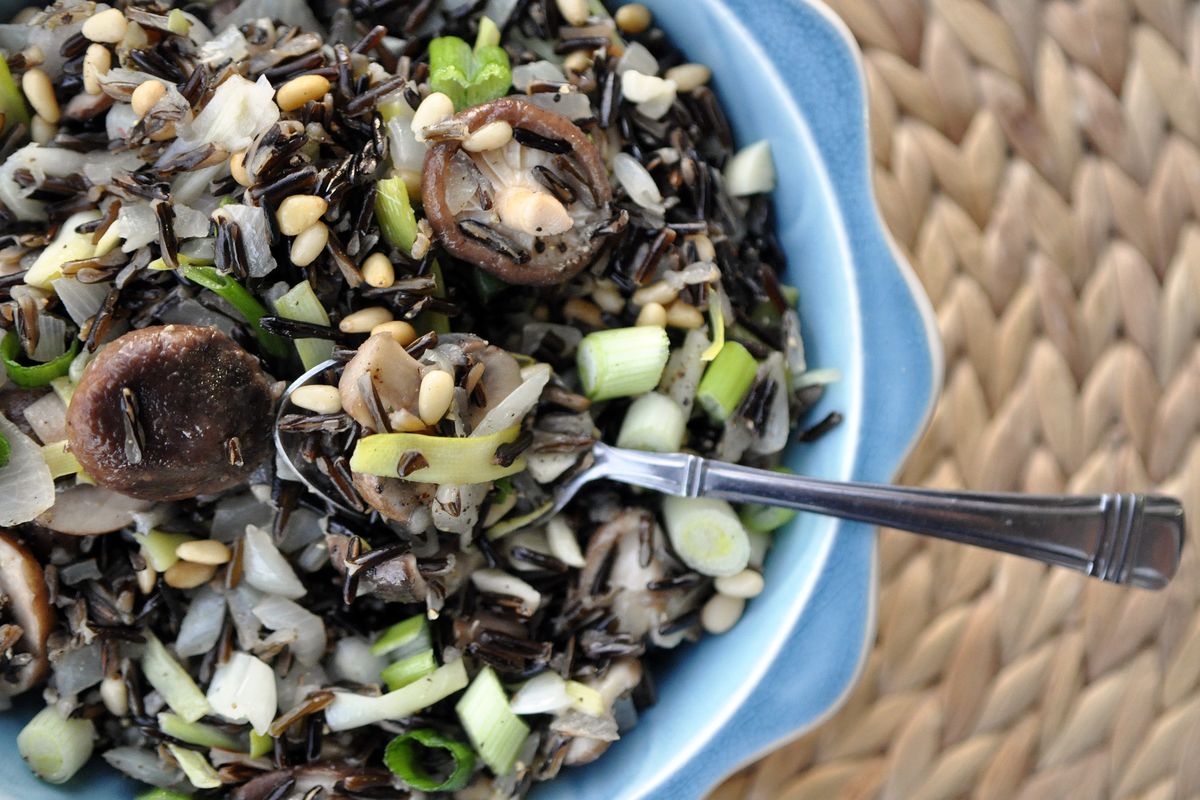Cook with cattails, no camping required

Cattails are one of the most common wild foods. But it never occurred to me to actually eat them until I saw the young, pale, green-and-white, leek-shaped shoots at the Thursday Market in the South Perry District.
“What do you do with them?” I asked the vendors, who assured me they were super in a simple sautée or stir-fry.
I was curious – and skeptical. After all, my Girl Scout career never advanced that far. And, as it turns out, cattails are excellent survival food.
“It is a good example of a food that is all around you,” Fred Demara wrote in “Eating on the Run,” his 2012 guide to survival foraging. Demara describes going “cattail camping” with a friend as kids in the Pacific Northwest with “only matches, salt, a poncho between us, jackknives, a No. 10 can to carry/cook in, a Red Ryder BB gun, and later a mail-order ‘Bowie’ knife bought from an ad in Boy’s Life with strawberry-picking money.”
The common cattail, or typha latifolia, is a forager’s favorite. The highly recognizable cigar-topped stalks are often called “Walmart of the Wild” or “Supermarket of the Swamp” because they provide food, shelter and fuel. Old, dry stalks can be used to build a fire. Plus, if you’re lost in North America and you find cattails, you’ve also likely come upon fresh water. They grow where it’s wet – near ponds, marshes, lakes, rivers.
“If I had to choose between surviving for a spell, barehanded, near a pond with catfish or one with cattails, I’d probably opt for the cattails, and not just because they are easier to catch with your hands,” Demara wrote.
Better yet, buy them at the farmers market and skip the whole getting-lost-in- the-wilderness part.
In early summer, before the fluff starts to form, the corndog-like heads are said to taste similar to sweet, white corn, especially when prepared like corn-on-the-cob: boiled and served with butter. You can also use the pollen to add flavor to pancakes, biscuits, bread and other baked goods, and remove the starch from fibrous, peeled rhizomes to make flour.
Jorge Cano, owner of Spokane’s CasaCano Farms, said he’s made flour from cattails. The yield was small. And, he said, “It took all day.”
For beginners, it sounds a bit intimidating. It also sounds like a whole bunch of work for little reward.
Still, at the start of CSA season, you might find cattail shoots in your box, and – as I’ve recently learned – there’s quite a lot you can do with the mild-tasting greens. You can pickle them. You can cook them in soups. You can experiment, adding them to recipes that call for fresh, green vegetables.
Madyson Versteeg, also of CasaCano Farms, said her favorite way to enjoy cattails is on bruschetta, or baguette rounds topped with goat cheese, garlic and sliced, sautéed shoots. She also eats them raw as a snack on the farm.
One of the most popular cattail recipes online comes from 2010’s “The Wild Vegan Cookbook” by Steve Brill. The chilled soup calls for making almond milk, then mixing in thinly sliced raw cattail shoots, finely chopped mint leaves and the juice from half of a lemon. I wasn’t that adventurous.
I sautéed the shoots in ghee with shallots, garlic, onions and mushrooms and added the mixture to wild rice with pine nuts for a simple pilaf. Even simpler: sauté the shoots in olive oil or butter – with maybe a little white wine, lemon juice, salt, pepper and garlic, and serve them as a side or in a noodle dish. Pasta primavera, perhaps?
With a little practice, they just might become a springtime, dinner-table staple – not just survival food.
Wild Rice Pilaf with Cattail Shoots and Cremini Mushrooms
From Adriana Janovich
1 bay leaf
1 teaspoon kosher salt, plus more to taste
2 cups wild rice
2 tablespoons ghee
1/2 cup yellow onion, finely chopped
2 cups cattail shoots, medium chopped
1/4 cup shallots, finely chopped
3 cloves garlic, minced
2 cups sliced cremini and shiitake mushrooms
1/2 cup pine nuts, toasted
1/4 cup green onions or chives, chopped , for garnish (optional)
Freshly cracked black pepper, to taste
Bring 8 cups of water to a boil in a large pot with bay leaf and 1 teaspoon salt. Add wild rice, reduce heat and simmer, uncovered, until rice is tender, about 1 hour. Drain well, remove and discard bay leaf, and set aside.
Heat ghee in a large skillet. Add the onion, cattail shoots, shallots, garlic and mushrooms, and cook over medium heat until onions are soft and translucent, and mushrooms begin to brown, about 10 minutes. Add to rice with pine nuts and stir to combine.
Place mixture in a serving dish, top with green onions or chives, then season to taste with salt and pepper. Serve hot.
Yield: about 8 (1-cup) servings